课程一(Neural Networks and Deep Learning),第三周(Shallow neural networks)—— 3.Programming Assignment : Planar data classification with a hidden layer
Planar data classification with a hidden layer
Welcome to the second programming exercise of the deep learning specialization. In this notebook you will generate red and blue points to form a flower. You will then fit a neural network to correctly classify the points. You will try different layers and see the results.

By completing this assignment you will:
- Develop an intuition of back-propagation and see it work on data.
- Recognize that the more hidden layers you have the more complex structure you could capture.
- Build all the helper functions to implement a full model with one hidden layer.
This assignment prepares you well for the upcoming assignment. Take your time to complete it and make sure you get the expected outputs when working through the different exercises. In some code blocks, you will find a "#GRADED FUNCTION: functionName" comment. Please do not modify it. After you are done, submit your work and check your results. You need to score 70% to pass. Good luck :) !
【中文翻译】
用有一个人隐藏层的神经网络进行平面数据分类
Planar data classification with one hidden layer
Welcome to your week 3 programming assignment. It's time to build your first neural network, which will have a hidden layer. You will see a big difference between this model and the one you implemented using logistic regression.
You will learn how to:
- Implement a 2-class classification neural network with a single hidden layer
- Use units with a non-linear activation function, such as tanh
- Compute the cross entropy loss
- Implement forward and backward propagation
【中文翻译】
欢迎您的第3周的编程作业。是时候建立你的第一个神经网络了, 这将有一个隐藏层。你会看到这个模型和你使用逻辑回归实现的一个很大的不同。
--------------------------------------------------------------------------------------------------------------------------
1 - Packages
Let's first import all the packages that you will need during this assignment.
- numpy is the fundamental package for scientific computing with Python.
- sklearn provides simple and efficient tools for data mining and data analysis.
- matplotlib is a library for plotting graphs in Python.
- testCases provides some test examples to assess the correctness of your functions
- planar_utils provide various useful functions used in this assignment
【中文翻译】
# Package imports
import numpy as np
import matplotlib.pyplot as plt
from testCases_v2 import *
import sklearn
import sklearn.datasets
import sklearn.linear_model
from planar_utils import plot_decision_boundary, sigmoid, load_planar_dataset, load_extra_datasets %matplotlib inline np.random.seed(1) # set a seed so that the results are consistent
2 - Dataset
First, let's get the dataset you will work on. The following code will load a "flower" 2-class dataset into variables X and Y.
【code】
X, Y = load_planar_dataset()
Visualize the dataset using matplotlib. The data looks like a "flower" with some red (label y=0) and some blue (y=1) points. Your goal is to build a model to fit this data.
【中文翻译】
使用 matplotlib 可视化数据集。数据看起来像一个 "花" ,由一些红色 (标签 y=0) 和一些蓝色 (y=1) 点组成。你的目标是建立一个模型来分类这些数据。
【code】
# Visualize the data:
plt.scatter(X[0, :], X[1, :], c=Y, s=40, cmap=plt.cm.Spectral);
【result】
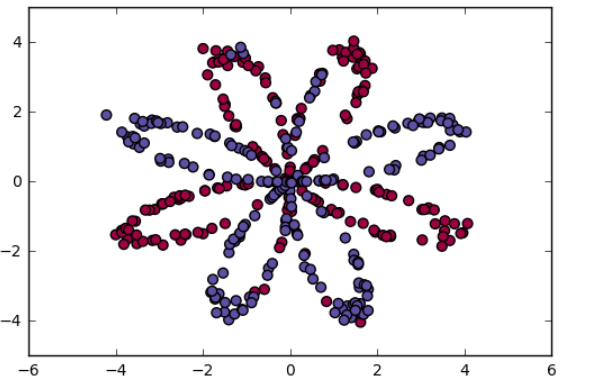
You have:
- a numpy-array (matrix) X that contains your features (x1, x2)
- a numpy-array (vector) Y that contains your labels (red:0, blue:1).
Lets first get a better sense of what our data is like.
Exercise: How many training examples do you have? In addition, what is the shape of the variables X and Y?
Hint: How do you get the shape of a numpy array? (help)
【code】
### START CODE HERE ### (≈ 3 lines of code)
shape_X = X.shape
shape_Y = Y.shape
m = X.shape[1] # training set size
### END CODE HERE ### print ('The shape of X is: ' + str(shape_X))
print ('The shape of Y is: ' + str(shape_Y))
print ('I have m = %d training examples!' % (m))
【result】
The shape of X is: (2, 400)
The shape of Y is: (1, 400)
I have m = 400 training examples!
Expected Output:
| shape of X | (2, 400) |
| shape of Y | (1, 400) |
| m | 400 |
--------------------------------------------------------------------------------------------------------------------------
3 - Simple Logistic Regression
Before building a full neural network, lets first see how logistic regression performs on this problem. You can use sklearn's built-in functions to do that. Run the code below to train a logistic regression classifier on the dataset.
【code】
# Train the logistic regression classifier
clf = sklearn.linear_model.LogisticRegressionCV();
clf.fit(X.T, Y.T);
You can now plot the decision boundary of these models. Run the code below.
【code】
# Plot the decision boundary for logistic regression
plot_decision_boundary(lambda x: clf.predict(x), X, Y)
plt.title("Logistic Regression") # Print accuracy
LR_predictions = clf.predict(X.T)
print ('Accuracy of logistic regression: %d ' % float((np.dot(Y,LR_predictions) + np.dot(1-Y,1-LR_predictions))/float(Y.size)*100) +
'% ' + "(percentage of correctly labelled datapoints)")
【result】
Accuracy of logistic regression: 47 % (percentage of correctly labelled datapoints)
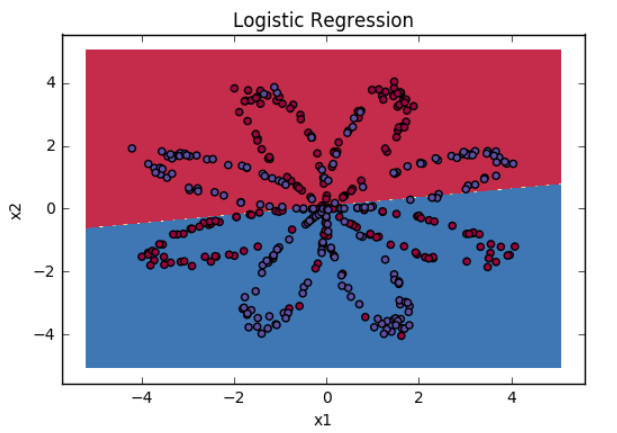
Expected Output:
| Accuracy | 47% |
Interpretation: The dataset is not linearly separable, so logistic regression doesn't perform well. Hopefully a neural network will do better. Let's try this now!
-------------------------------------------------------------------------------------------------------------------------
4 - Neural Network model
Logistic regression did not work well on the "flower dataset". You are going to train a Neural Network with a single hidden layer.
Here is our model:
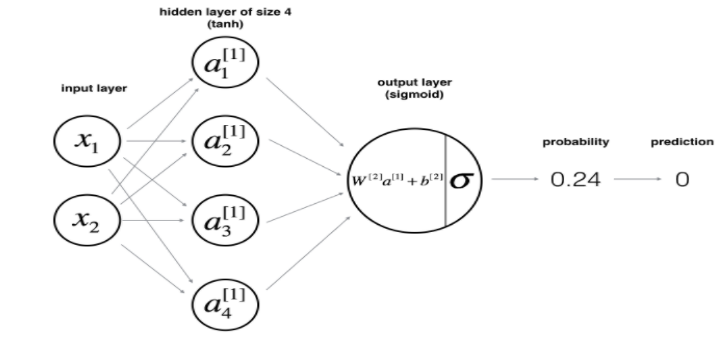
Mathematically:
For one example x(i)x(i):

Given the predictions on all the examples, you can also compute the cost J as follows:

Reminder: The general methodology to build a Neural Network is to:
1. Define the neural network structure ( # of input units, # of hidden units, etc).
2. Initialize the model's parameters
3. Loop:
- Implement forward propagation
- Compute loss
- Implement backward propagation to get the gradients
- Update parameters (gradient descent)
You often build helper functions to compute steps 1-3 and then merge them into one function we call nn_model(). Once you've built nn_model() and learnt the right parameters, you can make predictions on new data.
4.1 - Defining the neural network structure
Exercise: Define three variables:
- n_x: the size of the input layer
- n_h: the size of the hidden layer (set this to 4)
- n_y: the size of the output layer
Hint: Use shapes of X and Y to find n_x and n_y. Also, hard code the hidden layer size to be 4.
【code】
# GRADED FUNCTION: layer_sizes def layer_sizes(X, Y):
"""
Arguments:
X -- input dataset of shape (input size, number of examples)
Y -- labels of shape (output size, number of examples) Returns:
n_x -- the size of the input layer
n_h -- the size of the hidden layer
n_y -- the size of the output layer
"""
### START CODE HERE ### (≈ 3 lines of code)
n_x = X.shape[0]# size of input layer
n_h = 4
n_y = Y.shape[0] # size of output layer
### END CODE HERE ###
return (n_x, n_h, n_y)
X_assess, Y_assess = layer_sizes_test_case()
(n_x, n_h, n_y) = layer_sizes(X_assess, Y_assess)
print("The size of the input layer is: n_x = " + str(n_x))
print("The size of the hidden layer is: n_h = " + str(n_h))
print("The size of the output layer is: n_y = " + str(n_y))
【result】
The size of the input layer is: n_x = 5
The size of the hidden layer is: n_h = 4
The size of the output layer is: n_y = 2
Expected Output (these are not the sizes you will use for your network, they are just used to assess the function you've just coded).
| n_x | 5 |
| n_h | 4 |
| n_y | 2 |
4.2 - Initialize the model's parameters
Exercise: Implement the function initialize_parameters().
Instructions:
- Make sure your parameters' sizes are right. Refer to the neural network figure above if needed.
- You will initialize the weights matrices with random values.
- Use:
np.random.randn(a,b) * 0.01to randomly initialize a matrix of shape (a,b).
- Use:
- You will initialize the bias vectors as zeros.
- Use:
np.zeros((a,b))to initialize a matrix of shape (a,b) with zeros.
- Use:
【code】
# GRADED FUNCTION: initialize_parameters def initialize_parameters(n_x, n_h, n_y):
"""
Argument:
n_x -- size of the input layer
n_h -- size of the hidden layer
n_y -- size of the output layer Returns:
params -- python dictionary containing your parameters:
W1 -- weight matrix of shape (n_h, n_x)
b1 -- bias vector of shape (n_h, 1)
W2 -- weight matrix of shape (n_y, n_h)
b2 -- bias vector of shape (n_y, 1)
""" np.random.seed(2) # we set up a seed so that your output matches ours although the initialization is random. ### START CODE HERE ### (≈ 4 lines of code)
W1 = np.random.randn(n_h,n_x)*0.01
b1 = np.zeros((n_h,1)) #注意zeros()函数初始化的写法
W2 = np.random.randn(n_y,n_h)*0.01
b2 = np.zeros((n_y,1))
### END CODE HERE ### assert (W1.shape == (n_h, n_x))
assert (b1.shape == (n_h, 1))
assert (W2.shape == (n_y, n_h))
assert (b2.shape == (n_y, 1)) parameters = {"W1": W1,
"b1": b1,
"W2": W2,
"b2": b2} return parameters
n_x, n_h, n_y = initialize_parameters_test_case() parameters = initialize_parameters(n_x, n_h, n_y)
print("W1 = " + str(parameters["W1"]))
print("b1 = " + str(parameters["b1"]))
print("W2 = " + str(parameters["W2"]))
print("b2 = " + str(parameters["b2"]))
【result】
W1 = [[-0.00416758 -0.00056267]
[-0.02136196 0.01640271]
[-0.01793436 -0.00841747]
[ 0.00502881 -0.01245288]]
b1 = [[ 0.]
[ 0.]
[ 0.]
[ 0.]]
W2 = [[-0.01057952 -0.00909008 0.00551454 0.02292208]]
b2 = [[ 0.]]
Expected Output:
| W1 | [[-0.00416758 -0.00056267] [-0.02136196 0.01640271] [-0.01793436 -0.00841747] [ 0.00502881 -0.01245288]] |
| b1 | [[ 0.] [ 0.] [ 0.] [ 0.]] |
| W2 | [[-0.01057952 -0.00909008 0.00551454 0.02292208]] |
| b2 | [[ 0.]] |
4.3 - The Loop
Question: Implement forward_propagation().
Instructions:
- Look above at the mathematical representation of your classifier.
- You can use the function
sigmoid(). It is built-in (imported) in the notebook. - You can use the function
np.tanh(). It is part of the numpy library. - The steps you have to implement are:
- Retrieve each parameter from the dictionary "parameters" (which is the output of
initialize_parameters()) by usingparameters[".."]. - Implement Forward Propagation. Compute Z[1],A[1],Z[2]and A[2] (the vector of all your predictions on all the examples in the training set).
- Retrieve each parameter from the dictionary "parameters" (which is the output of
- Values needed in the backpropagation are stored in "
cache". Thecachewill be given as an input to the backpropagation function.
【中文翻译】
sigmoid()。它内置在笔记本中 (导入)。# GRADED FUNCTION: forward_propagation def forward_propagation(X, parameters):
"""
Argument:
X -- input data of size (n_x, m)
parameters -- python dictionary containing your parameters (output of initialization function) Returns:
A2 -- The sigmoid output of the second activation
cache -- a dictionary containing "Z1", "A1", "Z2" and "A2"
"""
# Retrieve each parameter from the dictionary "parameters"
### START CODE HERE ### (≈ 4 lines of code)
W1 = parameters["W1"] #
b1 = parameters["b1"]
W2 = parameters["W2"]
b2 = parameters["b2"]
### END CODE HERE ### # Implement Forward Propagation to calculate A2 (probabilities)
### START CODE HERE ### (≈ 4 lines of code)
Z1 = np.dot(W1, X)+b1
A1 = np.tanh(Z1)
Z2 = np.dot(W2,A1)+b2
A2 = sigmoid(Z2)
### END CODE HERE ### assert(A2.shape == (1, X.shape[1])) cache = {"Z1": Z1,
"A1": A1,
"Z2": Z2,
"A2": A2} return A2, cache
# GRADED FUNCTION: forward_propagation def forward_propagation(X, parameters):
"""
Argument:
X -- input data of size (n_x, m)
parameters -- python dictionary containing your parameters (output of initialization function) Returns:
A2 -- The sigmoid output of the second activation
cache -- a dictionary containing "Z1", "A1", "Z2" and "A2"
"""
# Retrieve each parameter from the dictionary "parameters"
### START CODE HERE ### (≈ 4 lines of code)
W1 = parameters["W1"] #
b1 = parameters["b1"]
W2 = parameters["W2"]
b2 = parameters["b2"]
### END CODE HERE ### # Implement Forward Propagation to calculate A2 (probabilities)
### START CODE HERE ### (≈ 4 lines of code)
Z1 = np.dot(W1, X)+b1
A1 = np.tanh(Z1)
Z2 = np.dot(W2,A1)+b2
A2 = sigmoid(Z2)
### END CODE HERE ### assert(A2.shape == (1, X.shape[1])) cache = {"Z1": Z1,
"A1": A1,
"Z2": Z2,
"A2": A2} return A2, cache
X_assess, parameters = forward_propagation_test_case()
A2, cache = forward_propagation(X_assess, parameters) # Note: we use the mean here just to make sure that your output matches ours.
print(np.mean(cache['Z1']) ,np.mean(cache['A1']),np.mean(cache['Z2']),np.mean(cache['A2']))
【result】
0.262818640198 0.091999045227 -1.30766601287 0.212877681719
Expected Output:
| 0.262818640198 0.091999045227 -1.30766601287 0.212877681719 |
Now that you have computed A[2] (in the Python variable "A2"), which contains a[2](i)for every example, you can compute the cost function as follows:

Exercise: Implement compute_cost() to compute the value of the cost J.
Instructions:
- There are many ways to implement the cross-entropy loss(损失熵). To help you, we give you how we would have implemented

logprobs = np.multiply(np.log(A2),Y)
cost = - np.sum(logprobs) # no need to use a for loop!
(you can use either np.multiply() and then np.sum() or directly np.dot()).
【code】
# GRADED FUNCTION: compute_cost def compute_cost(A2, Y, parameters):
"""
Computes the cross-entropy cost given in equation (13) Arguments:
A2 -- The sigmoid output of the second activation, of shape (1, number of examples)
Y -- "true" labels vector of shape (1, number of examples)
parameters -- python dictionary containing your parameters W1, b1, W2 and b2 Returns:
cost -- cross-entropy cost given equation (13)
""" m = Y.shape[1] # number of example # Compute the cross-entropy cost
### START CODE HERE ### (≈ 2 lines of code)
logprobs = np.multiply(np.log(A2),Y)+ np.multiply(np.log(1-A2),1- Y)
cost = - 1/m*np.sum(logprobs)
### END CODE HERE ### cost = np.squeeze(cost) # makes sure cost is the dimension we expect.
# E.g., turns [[17]] into 17
assert(isinstance(cost, float)) #cost的类型是不是float return cost
A2, Y_assess, parameters = compute_cost_test_case()
print("cost = " + str(compute_cost(A2, Y_assess, parameters)))
Expected Output:
| cost | 0.693058761... |
Using the cache computed during forward propagation, you can now implement backward propagation.
Question: Implement the function backward_propagation().
Instructions: Backpropagation is usually the hardest (most mathematical) part in deep learning. To help you, here again is the slide from the lecture on backpropagation. You'll want to use the six equations on the right of this slide, since you are building a vectorized implementation.
【中文翻译】
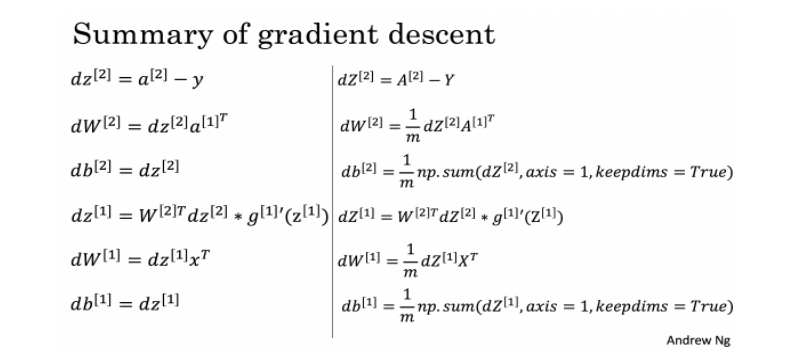
Tips:
- To compute dZ1 you'll need to compute g[1]′(Z[1]). Since g[1](.)is the tanh activation function, if a=g[1](z) then g[1]′(z)=1−a2. So you can compute g[1]′(Z[1]) using
(1 - np.power(A1, 2)).
【code】
# GRADED FUNCTION: backward_propagation def backward_propagation(parameters, cache, X, Y):
"""
Implement the backward propagation using the instructions above. Arguments:
parameters -- python dictionary containing our parameters(W1,b1,W2,b2)
cache -- a dictionary containing "Z1", "A1", "Z2" and "A2".
X -- input data of shape (2, number of examples)
Y -- "true" labels vector of shape (1, number of examples) Returns:
grads -- python dictionary containing your gradients with respect to different parameters
"""
m = X.shape[1] # First, retrieve W1 and W2 from the dictionary "parameters".
### START CODE HERE ### (≈ 2 lines of code)
W1 = parameters["W1"]
W2 = parameters["W2"]
### END CODE HERE ### # Retrieve(检索) also A1 and A2 from dictionary "cache".
### START CODE HERE ### (≈ 2 lines of code)
A1 = cache["A1"]
A2 = cache["A2"]
### END CODE HERE ### # Backward propagation: calculate dW1, db1, dW2, db2.
### START CODE HERE ### (≈ 6 lines of code, corresponding to 6 equations on slide above)
dZ2 = A2- Y
dW2 = 1/m*np.dot(dZ2, A1.T)
db2 = 1/m*np.sum(dZ2,axis=1,keepdims=True)
dZ1 = np.dot(W2.T,dZ2)*(1 - np.power(A1, 2))
dW1 = 1/m*np.dot(dZ1,X.T)
db1 = 1/m*np.sum(dZ1,axis=1,keepdims=True)
### END CODE HERE ### grads = {"dW1": dW1,
"db1": db1,
"dW2": dW2,
"db2": db2} return grads
parameters, cache, X_assess, Y_assess = backward_propagation_test_case() grads = backward_propagation(parameters, cache, X_assess, Y_assess)
print ("dW1 = "+ str(grads["dW1"]))
print ("db1 = "+ str(grads["db1"]))
print ("dW2 = "+ str(grads["dW2"]))
print ("db2 = "+ str(grads["db2"]))
【result】
dW1 = [[ 0.00301023 -0.00747267]
[ 0.00257968 -0.00641288]
[-0.00156892 0.003893 ]
[-0.00652037 0.01618243]]
db1 = [[ 0.00176201]
[ 0.00150995]
[-0.00091736]
[-0.00381422]]
dW2 = [[ 0.00078841 0.01765429 -0.00084166 -0.01022527]]
db2 = [[-0.16655712]]
Expected output:
| dW1 | [[ 0.00301023 -0.00747267] [ 0.00257968 -0.00641288] [-0.00156892 0.003893 ] [-0.00652037 0.01618243]] |
| db1 | [[ 0.00176201] [ 0.00150995] [-0.00091736] [-0.00381422]] |
| dW2 | [[ 0.00078841 0.01765429 -0.00084166 -0.01022527]] |
| db2 | [[-0.16655712]] |
Question: Implement the update rule. Use gradient descent. You have to use (dW1, db1, dW2, db2) in order to update (W1, b1, W2, b2).
General gradient descent rule: θ=θ−α∂J∂θθ=θ−α∂J∂θ where αα is the learning rate and θθ represents a parameter.
Illustration(图): The gradient descent algorithm with a good learning rate (converging) and a bad learning rate (diverging). Images courtesy of Adam Harley.
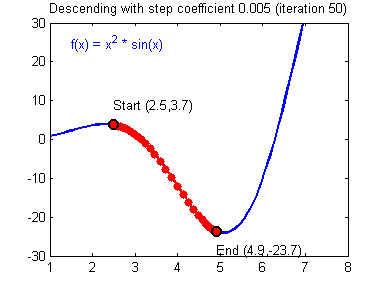
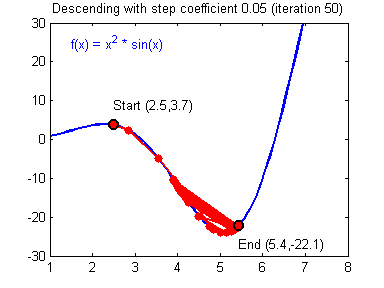
【code】
# GRADED FUNCTION: update_parameters def update_parameters(parameters, grads, learning_rate = 1.2):
"""
Updates parameters using the gradient descent update rule given above Arguments:
parameters -- python dictionary containing your parameters
grads -- python dictionary containing your gradients Returns:
parameters -- python dictionary containing your updated parameters
"""
# Retrieve each parameter from the dictionary "parameters"
### START CODE HERE ### (≈ 4 lines of code)
W1 = parameters["W1"]
b1 = parameters["b1"]
W2 = parameters["W2"]
b2 = parameters["b2"]
### END CODE HERE ### # Retrieve each gradient from the dictionary "grads"
### START CODE HERE ### (≈ 4 lines of code)
dW1 = grads["dW1"]
db1 = grads["db1"]
dW2 = grads["dW2"]
db2 = grads["db2"]
## END CODE HERE ### # Update rule for each parameter
### START CODE HERE ### (≈ 4 lines of code)
W1 = W1- learning_rate*dW1
b1 = b1- learning_rate*db1
W2 = W2- learning_rate*dW2
b2 = b2- learning_rate*db2
### END CODE HERE ### parameters = {"W1": W1,
"b1": b1,
"W2": W2,
"b2": b2} return parameters
parameters, grads = update_parameters_test_case()
parameters = update_parameters(parameters, grads) print("W1 = " + str(parameters["W1"]))
print("b1 = " + str(parameters["b1"]))
print("W2 = " + str(parameters["W2"]))
print("b2 = " + str(parameters["b2"]))
【result】
W1 = [[-0.00643025 0.01936718]
[-0.02410458 0.03978052]
[-0.01653973 -0.02096177]
[ 0.01046864 -0.05990141]]
b1 = [[ -1.02420756e-06]
[ 1.27373948e-05]
[ 8.32996807e-07]
[ -3.20136836e-06]]
W2 = [[-0.01041081 -0.04463285 0.01758031 0.04747113]]
b2 = [[ 0.00010457]]
Expected Output:
| W1 | [[-0.00643025 0.01936718] [-0.02410458 0.03978052] [-0.01653973 -0.02096177] [ 0.01046864 -0.05990141]] |
| b1 | [[ -1.02420756e-06] [ 1.27373948e-05] [ 8.32996807e-07] [ -3.20136836e-06]] |
| W2 | [[-0.01041081 -0.04463285 0.01758031 0.04747113]] |
| b2 | [[ 0.00010457]] |
4.4 - Integrate parts 4.1, 4.2 and 4.3 in nn_model()
Question: Build your neural network model in nn_model().
Instructions: The neural network model has to use the previous functions in the right order.
【code】
# GRADED FUNCTION: nn_model def nn_model(X, Y, n_h, num_iterations = 10000, print_cost=False):
"""
Arguments:
X -- dataset of shape (2, number of examples)
Y -- labels of shape (1, number of examples)
n_h -- size of the hidden layer
num_iterations -- Number of iterations in gradient descent loop
print_cost -- if True, print the cost every 1000 iterations Returns:
parameters -- parameters learnt by the model. They can then be used to predict.
""" np.random.seed(3)
n_x = layer_sizes(X, Y)[0] # (n_x, n_h, n_y) = layer_sizes(X, Y)
n_y = layer_sizes(X, Y)[2] # Initialize parameters, then retrieve W1, b1, W2, b2. Inputs: "n_x, n_h, n_y". Outputs = "W1, b1, W2, b2, parameters".
### START CODE HERE ### (≈ 5 lines of code)
parameters =initialize_parameters(n_x, n_h, n_y)
W1 = np.random.randn(n_h,n_x)*0.01
b1 = np.zeros((n_h,1)) #注意zeros()函数初始化的写法
W2 = np.random.randn(n_y,n_h)*0.01
b2 = np.zeros((n_y,1))
### END CODE HERE ### # Loop (gradient descent) for i in range(0, num_iterations): ### START CODE HERE ### (≈ 4 lines of code)
# Forward propagation. Inputs: "X, parameters". Outputs: "A2, cache".
A2, cache = forward_propagation(X, parameters) # Cost function. Inputs: "A2, Y, parameters". Outputs: "cost".
cost =compute_cost(A2, Y, parameters) # Backpropagation. Inputs: "parameters, cache, X, Y". Outputs: "grads".
grads = backward_propagation(parameters, cache, X, Y) # Gradient descent parameter update. Inputs: "parameters, grads". Outputs: "parameters".
parameters = update_parameters(parameters, grads, learning_rate = 1.2) ### END CODE HERE ### # Print the cost every 1000 iterations
if print_cost and i % 1000 == 0:
print ("Cost after iteration %i: %f" %(i, cost)) return parameters
X_assess, Y_assess = nn_model_test_case()
parameters = nn_model(X_assess, Y_assess, 4, num_iterations=10000, print_cost=True)
print("W1 = " + str(parameters["W1"]))
print("b1 = " + str(parameters["b1"]))
print("W2 = " + str(parameters["W2"]))
print("b2 = " + str(parameters["b2"]))
【result】
Cost after iteration 0: 0.692739
Cost after iteration 1000: 0.000218
Cost after iteration 2000: 0.000107
Cost after iteration 3000: 0.000071
Cost after iteration 4000: 0.000053
Cost after iteration 5000: 0.000042
Cost after iteration 6000: 0.000035
Cost after iteration 7000: 0.000030
Cost after iteration 8000: 0.000026
Cost after iteration 9000: 0.000023
W1 = [[-0.65848169 1.21866811]
[-0.76204273 1.39377573]
[ 0.5792005 -1.10397703]
[ 0.76773391 -1.41477129]]
b1 = [[ 0.287592 ]
[ 0.3511264 ]
[-0.2431246 ]
[-0.35772805]]
W2 = [[-2.45566237 -3.27042274 2.00784958 3.36773273]]
b2 = [[ 0.20459656]]
Expected Output:
| cost after iteration 0 | 0.692739 |
| ⋮⋮ | ⋮⋮ |
| W1 | [[-0.65848169 1.21866811] [-0.76204273 1.39377573] [ 0.5792005 -1.10397703] [ 0.76773391 -1.41477129]] |
| b1 | [[ 0.287592 ] [ 0.3511264 ] [-0.2431246 ] [-0.35772805]] |
| W2 | [[-2.45566237 -3.27042274 2.00784958 3.36773273]] |
| b2 | [[ 0.20459656]] |
4.5 Predictions
Question: Use your model to predict by building predict(). Use forward propagation to predict results.
Reminder:
As an example, if you would like to set the entries of a matrix X to 0 and 1 based on a threshold you would do: X_new = (X > threshold)
【code】
# GRADED FUNCTION: predict def predict(parameters, X):
"""
Using the learned parameters, predicts a class for each example in X Arguments:
parameters -- python dictionary containing your parameters
X -- input data of size (n_x, m) Returns
predictions -- vector of predictions of our model (red: 0 / blue: 1)
""" # Computes probabilities using forward propagation, and classifies to 0/1 using 0.5 as the threshold.
### START CODE HERE ### (≈ 2 lines of code)
A2, cache = forward_propagation(X, parameters) # cache -- a dictionary containing "Z1", "A1", "Z2" and "A2"
predictions =(A2>0.5)
### END CODE HERE ### return predictions
parameters, X_assess = predict_test_case() predictions = predict(parameters, X_assess)
print("predictions mean = " + str(np.mean(predictions)))
【result】
predictions mean = 0.666666666667
Expected Output:
| predictions mean | 0.666666666667 |
It is time to run the model and see how it performs on a planar dataset. Run the following code to test your model with a single hidden layer of nhnh hidden units.
【code】
# Build a model with a n_h-dimensional hidden layer
parameters = nn_model(X, Y, n_h = 4, num_iterations = 10000, print_cost=True) # Plot the decision boundary
plot_decision_boundary(lambda x: predict(parameters, x.T), X, Y)
plt.title("Decision Boundary for hidden layer size " + str(4))
【result】
Cost after iteration 0: 0.693048
Cost after iteration 1000: 0.288083
Cost after iteration 2000: 0.254385
Cost after iteration 3000: 0.233864
Cost after iteration 4000: 0.226792
Cost after iteration 5000: 0.222644
Cost after iteration 6000: 0.219731
Cost after iteration 7000: 0.217504
Cost after iteration 8000: 0.219454
Cost after iteration 9000: 0.218607
<matplotlib.text.Text at 0x7fbd5a54fdd8>
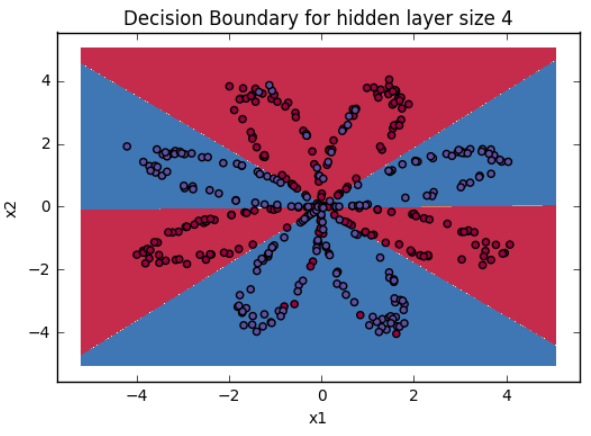
Expected Output:
| Cost after iteration 9000 | 0.218607 |
【code】
# Print accuracy
predictions = predict(parameters, X)
print ('Accuracy: %d' % float((np.dot(Y,predictions.T) + np.dot(1-Y,1-predictions.T))/float(Y.size)*100) + '%') #把predictions和Y相同的找出来
【result】
Accuracy: 90%
Expected Output:
| Accuracy | 90% |
Accuracy is really high compared to Logistic Regression. The model has learnt the leaf patterns of the flower! Neural networks are able to learn even highly non-linear decision boundaries, unlike logistic regression.
Now, let's try out several hidden layer sizes.
【中文翻译】
4.6 - Tuning hidden layer size (optional/ungraded exercise)
Run the following code. It may take 1-2 minutes. You will observe different behaviors of the model for various hidden layer sizes.
【code】
# This may take about 2 minutes to run plt.figure(figsize=(16, 32))
hidden_layer_sizes = [1, 2, 3, 4, 5, 20, 50]
for i, n_h in enumerate(hidden_layer_sizes):
plt.subplot(5, 2, i+1) # ???
plt.title('Hidden Layer of size %d' % n_h)
parameters = nn_model(X, Y, n_h, num_iterations = 5000)
plot_decision_boundary(lambda x: predict(parameters, x.T), X, Y) # ???
predictions = predict(parameters, X)
accuracy = float((np.dot(Y,predictions.T) + np.dot(1-Y,1-predictions.T))/float(Y.size)*100)
print ("Accuracy for {} hidden units: {} %".format(n_h, accuracy))
【result】
Accuracy for 1 hidden units: 67.5 %
Accuracy for 2 hidden units: 67.25 %
Accuracy for 3 hidden units: 90.75 %
Accuracy for 4 hidden units: 90.5 %
Accuracy for 5 hidden units: 91.25 %
Accuracy for 20 hidden units: 90.0 %
Accuracy for 50 hidden units: 90.25 %
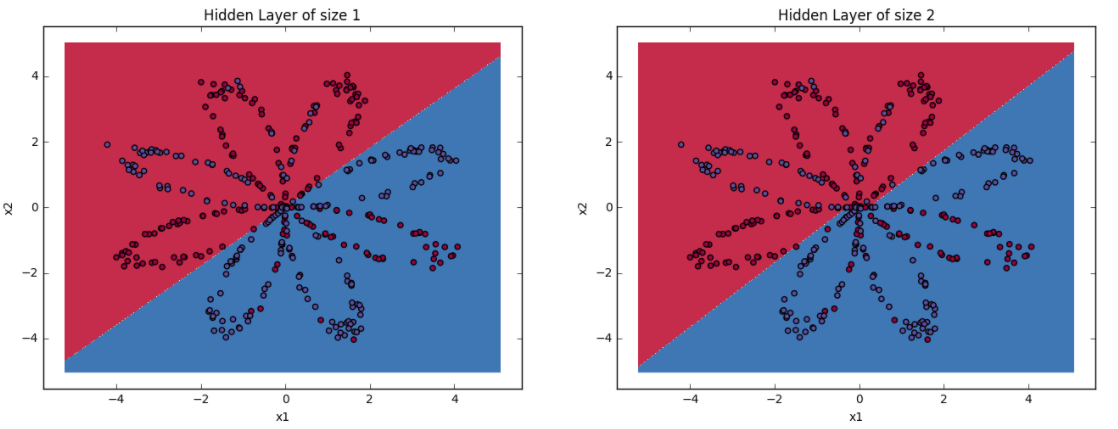

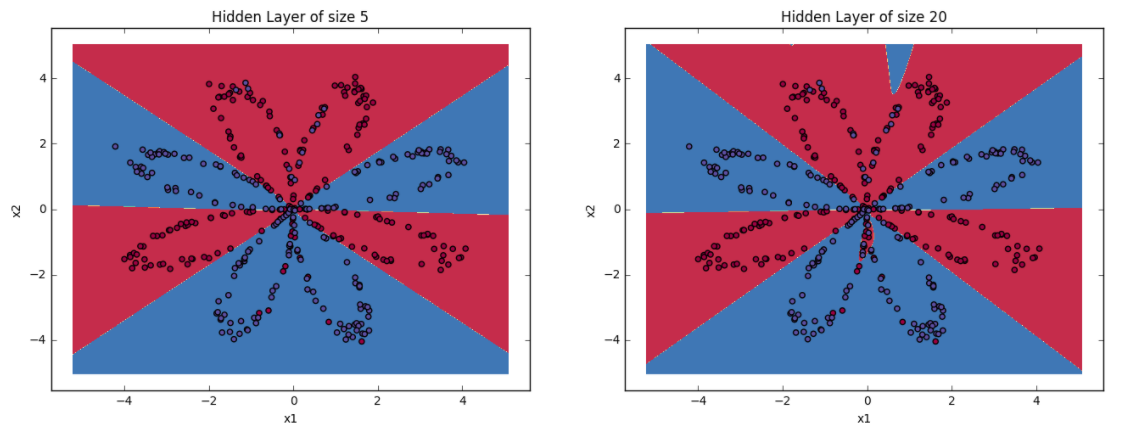
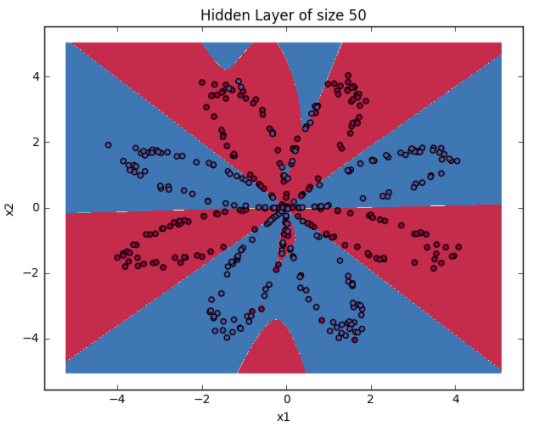
Interpretation:
- The larger models (with more hidden units) are able to fit the training set better, until eventually the largest models overfit the data.
- The best hidden layer size seems to be around n_h = 5. Indeed, a value around here seems to fits the data well without also incurring noticable overfitting.
- You will also learn later about regularization, which lets you use very large models (such as n_h = 50) without much overfitting.
Optional questions:
Note: Remember to submit the assignment but clicking the blue "Submit Assignment" button at the upper-right.
Some optional/ungraded questions that you can explore if you wish:
- What happens when you change the tanh activation for a sigmoid activation or a ReLU activation?
- Play with the learning_rate. What happens?
- What if we change the dataset? (See part 5 below!
You've learnt to:
- Build a complete neural network with a hidden layer
- Make a good use of a non-linear unit
- Implemented forward propagation and backpropagation, and trained a neural network
- See the impact of varying the hidden layer size, including overfitting.
Nice work!
5) Performance on other datasets
If you want, you can rerun the whole notebook (minus the dataset part) for each of the following datasets.
【code】
# Datasets
noisy_circles, noisy_moons, blobs, gaussian_quantiles, no_structure = load_extra_datasets() datasets = {"noisy_circles": noisy_circles,
"noisy_moons": noisy_moons,
"blobs": blobs,
"gaussian_quantiles": gaussian_quantiles} ### START CODE HERE ### (choose your dataset)
dataset = "blobs"
### END CODE HERE ### X, Y = datasets[dataset]
X, Y = X.T, Y.reshape(1, Y.shape[0]) # make blobs binary #变成二进制数
if dataset == "blobs":
Y = Y%2 # Visualize the data
plt.scatter(X[0, :], X[1, :], c=Y, s=40, cmap=plt.cm.Spectral);
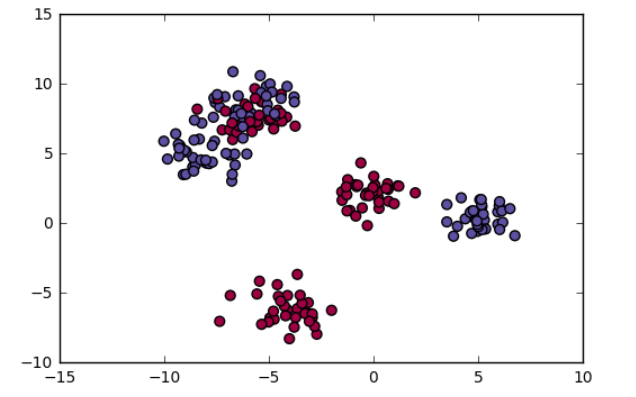
Congrats on finishing this Programming Assignment!
Reference:
课程一(Neural Networks and Deep Learning),第三周(Shallow neural networks)—— 3.Programming Assignment : Planar data classification with a hidden layer的更多相关文章
- Neural Networks and Deep Learning(week3)Planar data classification with one hidden layer(基于单隐藏层神经网络的平面数据分类)
Planar data classification with one hidden layer 你会学习到如何: 用单隐层实现一个二分类神经网络 使用一个非线性激励函数,如 tanh 计算交叉熵的损 ...
- 吴恩达《深度学习》-第一门课 (Neural Networks and Deep Learning)-第三周:浅层神经网络(Shallow neural networks) -课程笔记
第三周:浅层神经网络(Shallow neural networks) 3.1 神经网络概述(Neural Network Overview) 使用符号$ ^{[
- 【面向代码】学习 Deep Learning(三)Convolution Neural Network(CNN)
========================================================================================== 最近一直在看Dee ...
- 课程一(Neural Networks and Deep Learning),第二周(Basics of Neural Network programming)—— 4、Logistic Regression with a Neural Network mindset
Logistic Regression with a Neural Network mindset Welcome to the first (required) programming exerci ...
- 课程一(Neural Networks and Deep Learning),第一周(Introduction to Deep Learning)—— 2、10个测验题
1.What does the analogy “AI is the new electricity” refer to? (B) A. Through the “smart grid”, AI i ...
- 课程一(Neural Networks and Deep Learning),第一周(Introduction to Deep Learning)—— 1、经常提及的问题
Frequently Asked Questions Congratulations to be part of the first class of the Deep Learning Specia ...
- 课程一(Neural Networks and Deep Learning),第二周(Basics of Neural Network programming)—— 3、Python Basics with numpy (optional)
Python Basics with numpy (optional)Welcome to your first (Optional) programming exercise of the deep ...
- 课程一(Neural Networks and Deep Learning),第一周(Introduction to Deep Learning)—— 0、学习目标
1. Understand the major trends driving the rise of deep learning.2. Be able to explain how deep lear ...
- 课程一(Neural Networks and Deep Learning),第二周(Basics of Neural Network programming)—— 0、学习目标
1. Build a logistic regression model, structured as a shallow neural network2. Implement the main st ...
随机推荐
- Router types
Inq-n. Flits are stored at the input of the router. Each input unit is connected to the switch by as ...
- Booksim的运行
1.下载flex和bison解压到/home/cp/booksim2-master/src; 2.进入flex.bison的目录下分别执行: ./configure make make install ...
- c语言const和c++const
1.常量 常量是指值不能被改变的量,又叫做字面值 1.1常量分类 1)字符常量:'a', 'A', '*'. 2)字符串常量:"helloworld","ilovechi ...
- SQL中的split方法的使用
参数说明: 1.@String :需要split的字符串 2.@Delimiter :格式化时分隔符 3.@index :返回split后数组的值 ), ),)) ) AS BEGIN )) ) DE ...
- js格式化文件大小, 输出成带单位的字符串工具
/** * 格式化文件大小, 输出成带单位的字符串 * @method formatSize * @grammar formatSize( size ) => String * @grammar ...
- Ubuntu 12.10 安装VirtualBox增强功能
原文链接:http://fengbaoxp.iteye.com/blog/1871825 Ubuntu 12.10 Desktop 首先,通过VirtualBox菜单(设备->安 ...
- BeautifulSoup学习心得(一)
[BeautifulSoup最简介] BeautifulSoup,是Python中的一个第三方库,用于帮助解析Html/XML等内容,便于实现后期的内容提取等方面的工作. BeautifulSoup官 ...
- KindEditor4.x整合教程-Xproer.WordPaster
1.1. 集成到KindEditor4.x 主要步骤如下: 1.上传插件文件夹 2.上传WordPaster文件夹 3.在引用页面为KindEditor增加插件按钮 <html xmlns= ...
- Ng第十六课:推荐系统(Recommender Systems)
16.1 问题形式化 16.2 基于内容的推荐系统 16.3 协同过滤 16.4 协同过滤算法 16.5 矢量化:低秩矩阵分解 16.6 推行工作上的细节:均值归一化 16.1 问题形式 ...
- spring-mvc源码阅读笔记
简要的做一些spring-mvc部分的源码学习笔记 Spring-mvc做的工作主要是俩大方面吧:一个是初始化一个ioc容器,一个是mvc部分的控制和视图模块的实现. 先说下ioc容器的初始化部分:i ...
